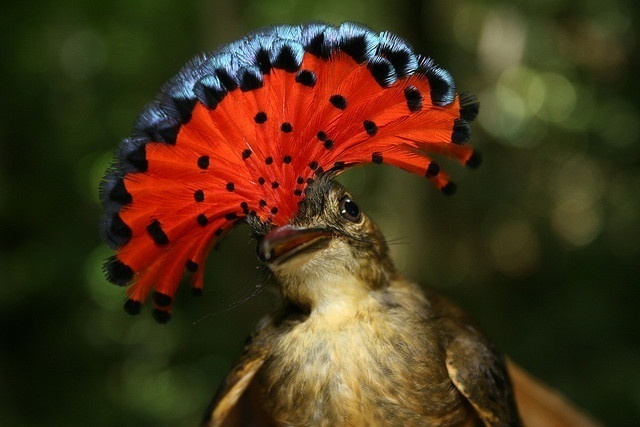Meet the Royal Flycatcher – The most luxurious bird in the bird world
The royal flycatcher is a name used for roughly four species of birds in the genus Onychorhynchus within the family Tityridae. “Royal” refers to the exotic feather display on the crown of the bird’s head, which is a brilliant array of red, yellow, white, blue and/or black.
The Royal Flycatchers use this brilliant, colorful plumage as a show of display during courtship rituals, after mating, while preening, in competition with other males over breeding or territory, or while being handled. Otherwise the plumed crest is lying flat.

Royal Flycatcher Facts
- Royal flycatchers are mostly brown with a rufous tails and long bills, along with, of course, the fantastic crest. The crests are red to orange (being paler in females), with black and blue spotting. The Amazonian and Northern birds are around 7 inches (18 cm) long.
-
- Royal Flycatchers build very large nests (sometimes up to 6 feet long) on branches near water. The nest hangs over the water which makes it hard for predators to reach.

Royal Flycatcher Crest
The video below shows the impressive and rarely seen crown display of a Royal Flycatcher caught in one of the Fauna Forever Tambopata Bird Team’s mist nets during the NGO’s long-term monitoring of human impacts on the Tambopata region of Peru’s Amazon rainforest.
Royal Flycatcher Species
Two of the genus species are considered to be non-threatened as far as the IUCN is concerned:
-
- the Amazonian Royal Flycatcher, found in the wilds of Central and South America and as far as Peru, Bolivia and Ecuador;
- and the Northern Royal Flycatcher, found mostly in Mexico, but as far south as Colombia and Venezuela.

The other two are considered vulnerable and potentially at risk of extinction due to habitat destruction from dry woodlands leading to forest fires, and human impact. These are:
- the Pacific Royal Flycatcher (Onychorynchus occidentalis) of southwest Ecuador and northwest Peru;
- and the Atlantic Royal Flycatcher (Onychorynchus swainsoni) of southeast Brazil.
